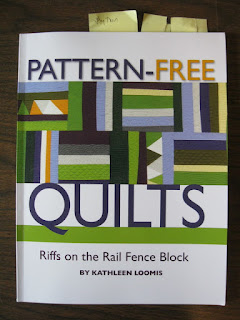August 30, 2015
Kathleen Loomis' new book: Pattern-Free Quilts
I was the lucky winner of a copy of Kathleen Loomis' new book, Pattern-Free Quilts: Riffs on the Rail Fence Block. I have long followed Loomis' blog, Art with a Needle, on which she usually writes about the sophisticated, challenging, stunning art quilts that she makes, and which have been shown in the top quilt/fiberart exhibitions such as Quilt National, Color Improvisations, and Quilts=Arts=Quilts. Her art quilts are distinguished by an intensity of design that requires a vast reservoir of persistence and commitment to carry off. See, for example, her postage quilts, or her fine lines series. But she also enjoys making simpler quilts. As she explains: "For almost 15 years, I have been working fulltime as a quilt artist. I've made hundreds of quilts that have been exhibited throughout the United States and Europe. But I still will make a baby quilt at the drop of a hat, and have a deep love for quilts of every style and use, whether they're made for show, for a living room wall or for somebody's bed" (p. 5). I found it reassuring to know that this tremendously accomplished artist also enjoys quilting simpler things!
I have made many quilts without patterns, include a number based on the rail fence block, but Loomis' book still has given me a lot to think about. The book opens with a thoughtful discussion of why one would want to make a quilt without starting with a pattern. Her guiding advice is "Sew first, plan second." A plan does develop, but in response to what one begins to sew. Loomis doesn't explain why she uses the term "pattern-free" rather than "improvisational," and her method certainly has much in common with the improvisation strategies taught by Jean Wells, Gwen Marston, Sherri Lynn Woods, Jacquie Gehring, and others. I would say that Loomis brings planning (even with no pattern) into the process sooner than most others, and she also focuses on building quilts out of blocks. By focusing in the book on one type of block--rail fence--Loomis can play out a wide variety of ways of approaching a block, and she gives clear, detailed instructions for a number of variations. I appreciated, for example, her instructions for three different ways to piece wedge-shaped or diagonal "rails" (pp. 50-53).
The book includes a gallery of about 25 quilts that use rail-fence in inspiring ways, from the simple to the complex. Most of the quilts are by Loomis, but there are also a few by other artists (Terry Jarrard-Dimond, Zoe Willis, Norma Schlager, Kathleen Wilkins, Melinda Snyder). I would definitely recommend this book to quilters at all levels.
Subscribe to:
Post Comments (Atom)


Hi Penny! Thank you for the kind words. I'm so glad you like the book and hope it gives you lots of new ideas.
ReplyDeleteI don't use the word "improvisational" because I think it has become code for a certain style, which may be more restrictive than what I have in mind. More important, code words can be scary to people who don't know the code. But I definitely an a practitioner of improvisational quilting -- heck, I have spent 17 weeks studying with Nancy Crow -- and if you want to think of these quilts as improvisational than I am delighted to have them described that way!
Hi Kathleen, I have been trying to buy your book Pattern Free Books but am having trouble with Create Space. Can I buy a book from you directly or do I have to go through Create Space. Thanks for your help. Caren
ReplyDeleteCaren--I doubt Kathleen will see your comment here. You can contact her directly through her blog: http://artwithaneedle.blogspot.com/
DeleteThis comment has been removed by the author.
ReplyDelete